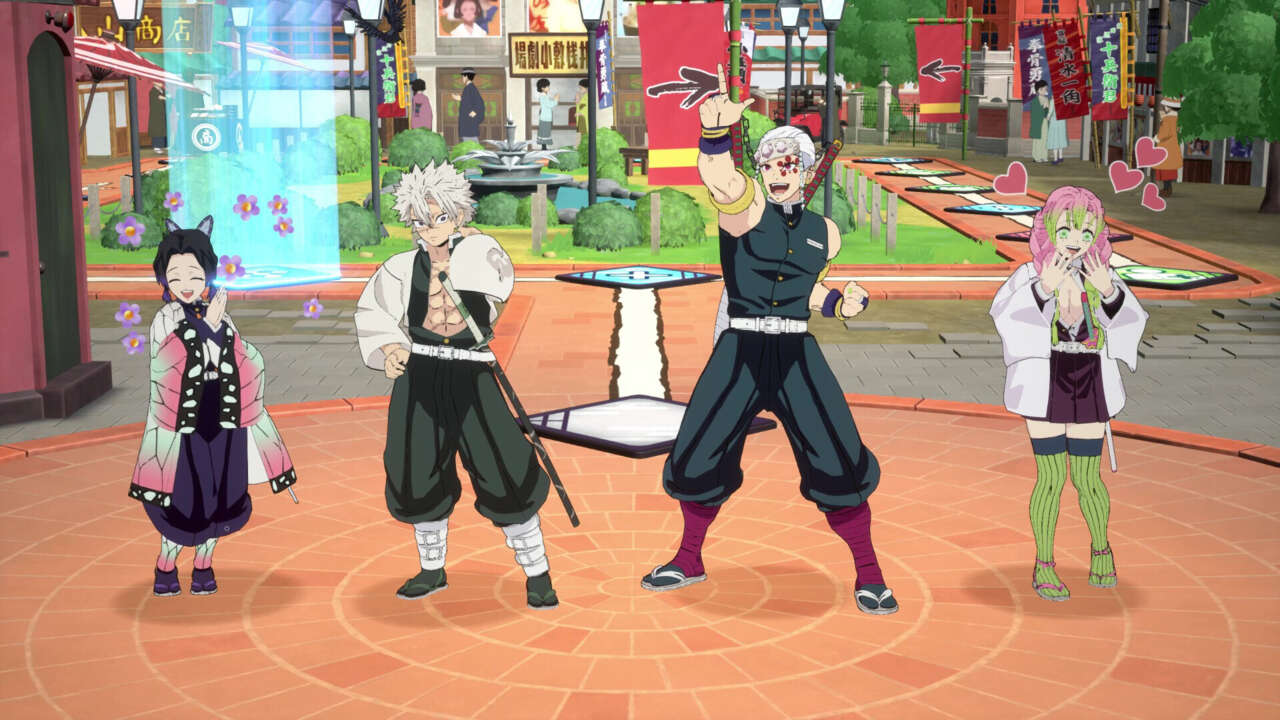Demon Slayer: Kimetsu no Yaiba is a wildly popular anime and manga series that stars a captivating cast of characters all seeking to protect innocents from insidious threats. My wife and I are huge fans of the show to the point that we’ve obtained dozens of Banpresto, Figurizm, and Masterlise figures for our humble collection. It’s also why I was intrigued by Demon Slayer: Sweep the Board!, a virtual board game adaptation of the series from CyberConnect 2 and Sega.
Following its release on Nintendo Switch this past April, Demon Slayer: Sweep the Board has been released on additional platforms. Unfortunately, however, it seems my wait for Sweep the Board to come to PC was not worth it. After nearly 10 hours of playing, I still have a hard time discerning just who exactly this game was made for. From clunky controls to boring minigames, Sweep the Board feels like a party game that lacks any sense of “party.”
Demon Slayer: Sweep the Board adapts several arcs of the manga and anime into Mario Party-esque layouts. From Asakusa and Mount Fujikasane in Board 1 to the Swordsmith Village in Board 5, each map is chock-full of references and nods to moments from the show, which was a treat for me as a fan. For instance, there are multiple paths in Mt. Natagumo that take you to Tsuzumi Mansion, which has a mysterious drum that causes characters inside the building to move to random locations. The Swordsmith Village, meanwhile, has hot springs, mechanical training dolls, and Haganezuka chasing you around. Those familiar with the source material will no doubt get a kick out of the references, albeit a brief one.
Players traverse the board by rolling dice and moving across spaces, with branching paths that lead to other areas. Likewise, maps have their own modes of transportation in keeping with their respective themes, such as boats that take you from Asakusa to Northwest Town, rickshaws in Yoshiwara Entertainment District, and the Mugen Train going around the tracks. There are plenty of NPCs to encounter when you land on certain spaces, too, including Tamayo’s cat, Goto (one of the Kakushi), Tengen Uzui’s honeys, and more, leading to a fair amount of replayability.
As far as characters go, Sweep the Board lets you choose from 12 heroes, including the main trio of Tanjiro, Zenitsu, and Inosuke. They’re joined by Hashira like Mitsuri, Gyomei, Rengoku, Sanemi, and more. Curiously enough, Nezuko isn’t playable, but she does appear as a support character who helps the player in last place, usually by adding an extra dice roll or handing a free item to them. I actually like this concept since, although Nezuko is absolutely vicious in her Awakened demon form, she’s still a child that everyone is protective of. It makes more sense to have her assist than play an active role, much like in the series.
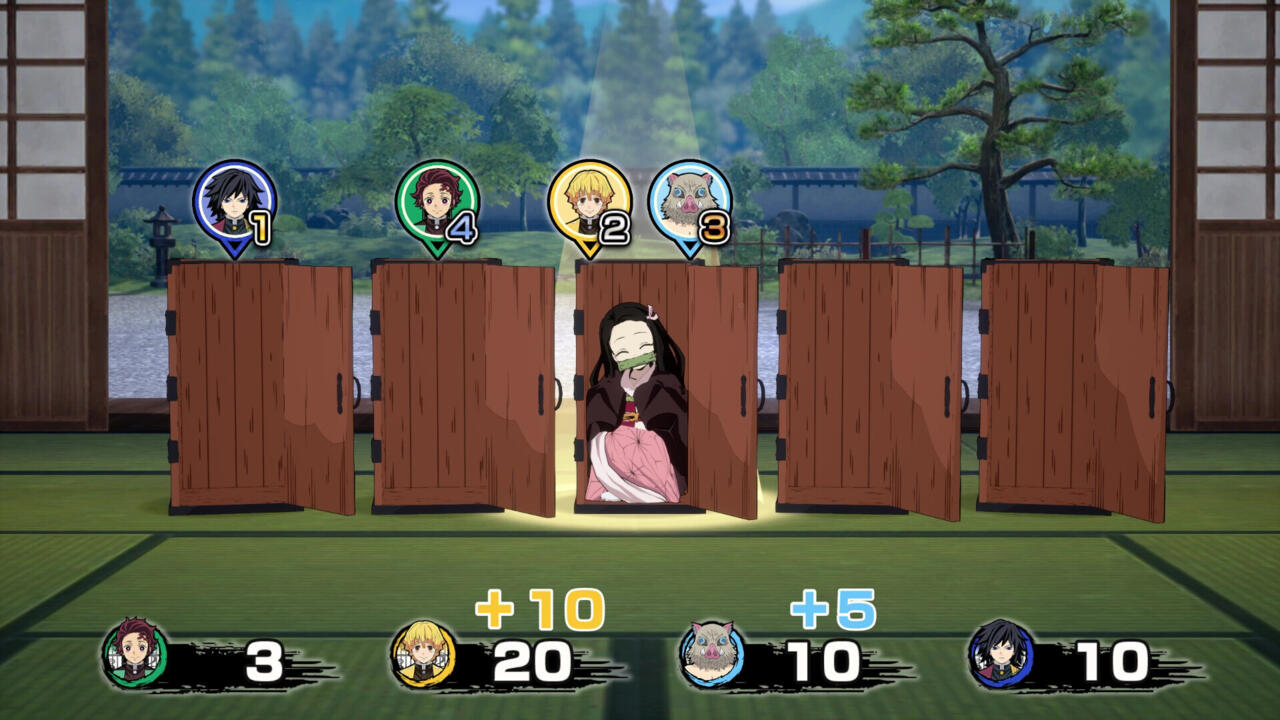
Characters in the game are beautifully rendered and animated; the original cast also did the Japanese and English voiceovers, meaning I found myself immersed right down to the most minute details. Zenitsu’s giddy reactions, Inosuke’s brashness, Shinobu’s cheerful disposition, and Giyu’s nonchalant remarks all effectively evoke the source material. My only gripe here is that characters don’t have unique perks or abilities, which would’ve been apt for a board game where you control powerful fighters. Instead, everyone just has the usual dice rolls and Slayer Dice that grant samey bonuses.
Your main goal in Demon Slayer: Sweep the Board is to amass Rank Points at the end of a match, which can be as short as five turns or as time-consuming as 30 turns. At the start of each day, players participate in a variety of minigames. There were a select few that I really enjoyed, such as Team Memory Matching which, as the term implies, is all about flipping portraits until you find a match, and Zenko’s Zealous Performance, which is akin to a musical rhythm game. My favorite, by far, is Don’t Miss a Beat! where I had to run through Tsuzumi Mansion’s twisting hallways, all while jumping over pits and razor-sharp projectiles thrown by Kyogai the Drum Demon.
However, several minigames were overly simple, hilariously easy, or downright boring. For example, Last One Jumping is a skipping rope minigame where I just had to press a button at the right time, while Demon Sleigh-er had me move side to side to pass through speed bursts while avoiding obstacles. Some activities even occurred twice during the same match, which made the whole endeavor repetitive to a fault.
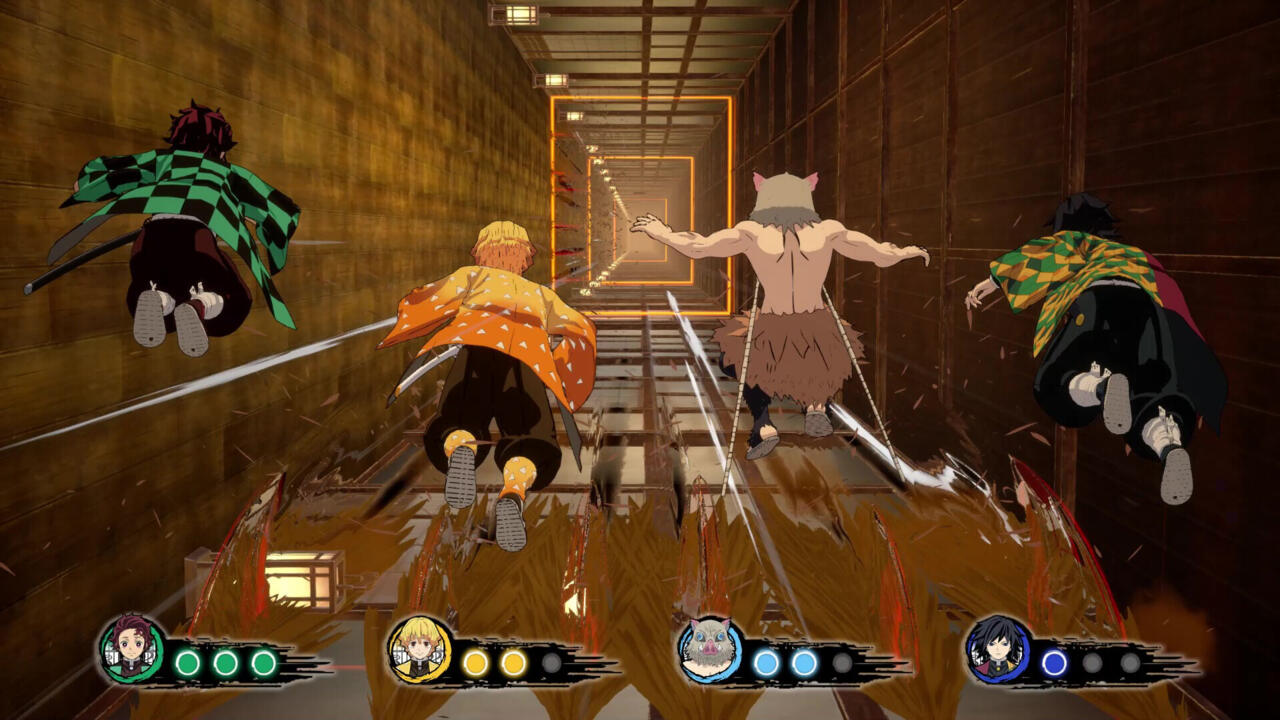
Regrettably, the controls can be unresponsive or janky at times, too. Demon Slayer: Sweep the Board offers solo play, online play, and local split-screen for up to four people (with any remaining slots controlled by the CPU). For local split-screen, I decided to use a keyboard while my wife used a Logitech F310 gamepad. Playing on a gamepad was significantly more comfortable than using a keyboard, since the latter led to cumbersome moments especially in minigames that required the use of the WASD keys to trace drawings or follow a diagonal direction. Worse, I noticed button prompts would change in the middle of a game–rolling a die and ending a dialogue usually meant pressing the “E” key, but there were instances when the “Q” key had to be pressed instead. I couldn’t tell if this was a bug due to a keyboard and gamepad setup for local play.
The board switches to its night phase once a player has reached the destination spot, which is also when Greater Demons spawn. These powerful enemies keep with the theme of each board, with Yahaba, Susamaru, and the Hand Demon emerging in Asakusa/Mt. Fujikasane, Enmu and Akaza in the Mugen Train, Gyutaro and Daki in the Entertainment District, and so on. I was impressed by the inclusion of these opponents, which were presented as special boss encounters complete with short cutscenes from the anime. Even Muzan shows up several turns in, extending the night phase, so to speak, and increasing the number of threats.
My only complaint here is that boss battles against Greater Demons are still your run-of-the-mill button mash or quick-time event affairs with little variety or challenge. There are a couple of notable exceptions, such as the Daki encounter, though this is mostly because button prompts appeared in different positions onscreen, making the battle more confusing than exciting. It was disappointing to see boss battles themselves turn into dull and uninspired activities.
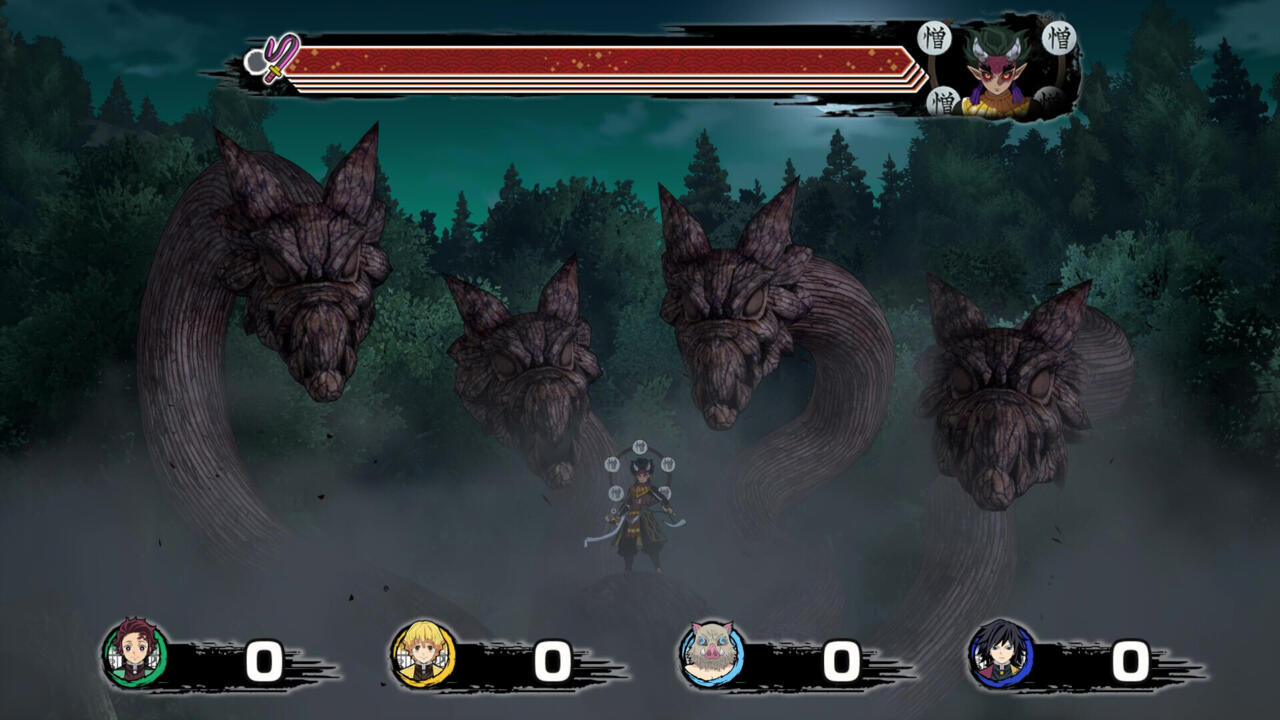
The most glaring shortcoming of Demon Slayer: Sweep the Board, however, is that it’s hardly something that can be considered a competitive board game or party game. When you think of other titles and franchises in these genres, such as Mario Party Superstars, The Jackbox Party Pack, Talisman, Catan, or even Monopoly, you’re either looking for chaotic romps, memorable and fun minigames, or ways to sabotage and stymie your opponent’s progress. The mere notion of someone leading the pack, and the knowledge that you can snatch their hard-earned rewards or their lead from under their nose, creates tense, exasperating, and oftentime amusing moments.
Sadly, these moments are few and far between in Demon Slayer: Sweep the Board. During the course of my review, I kept checking for perks that would allow me to steal goodies from other players or claim their Hashira ally as my own, but it looks like these mechanics don’t exist. Outside of a couple of consumable items–one that forces all players to move to my current location and another that makes me swap places with a target–I couldn’t create scenarios that would flip the table on another person, to everyone else’s raucous laughter.
At best, Demon Slayer: Sweep the Board is just a race to reach destination spots or Greater Demon spots to earn more Rank Points. Regardless of how well I did or how high my score was, minigames themselves only granted a smattering of coins to purchase items, and victories against Greater Demons offered but a handful of Rank Points. By the same token, the randomized way in which these spots showed up sometimes gave advantages to the closest player, and I had no control over these occurrences.
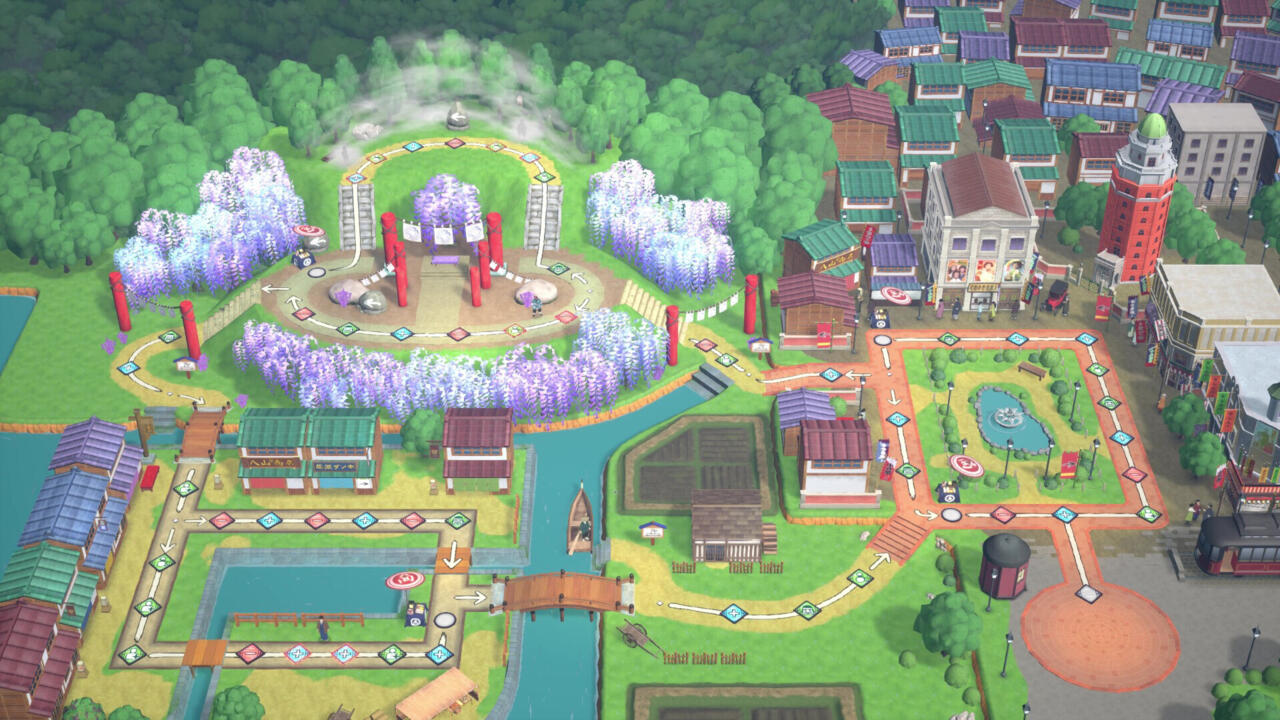
Likewise, I was surprised to see that post-game rewards handed out by Kagaya, the mentor of the Hashira, were also random. In one match, bonus Rank Points were given to the one who spent the most gold. I then used up a lot of gold during my next run, only for the special reward to be given to the player who moved the most number of spaces. Outside of the main mode, it’s possible to retry each minigame and boss encounter in quick runs, as well as spend coins to unlock cosmetic rewards like stickers, anime avatars, alternate attires, and wallpapers, but it’s not very exciting to do.
Despite being a huge fan of the series Demon Slayer: Sweep the Board offered very little to keep me entertained. A few hours in, the experience became repetitive and tedious to a degree that it’s hard to recommend to even the most ardent of manga and anime enthusiasts. You’re better off grabbing The Hinokami Chronicles, made by the same studio, if you’re into Demon Slayer, and those who prefer party games or board games already have a plethora of other options.
